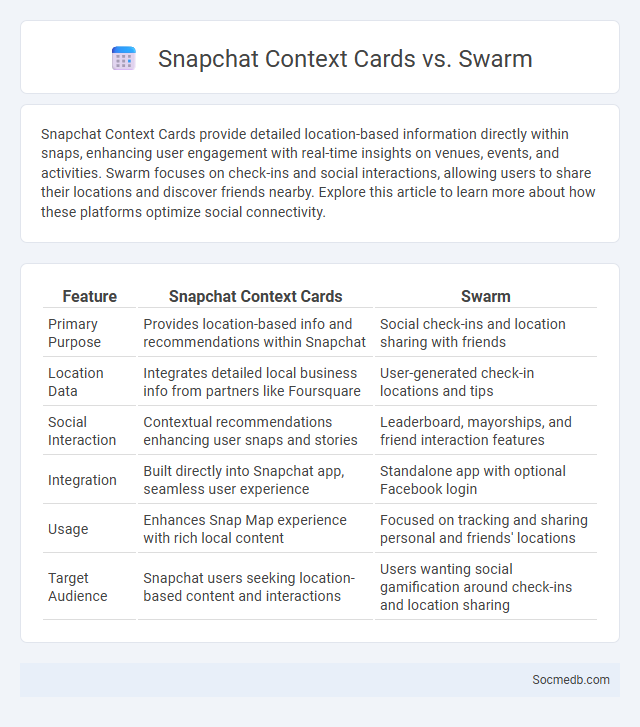
Photo illustration: Snapchat Context Cards vs Swarm
Snapchat Context Cards provide detailed location-based information directly within snaps, enhancing user engagement with real-time insights on venues, events, and activities. Swarm focuses on check-ins and social interactions, allowing users to share their locations and discover friends nearby. Explore this article to learn more about how these platforms optimize social connectivity.
Table of Comparison
| Feature | Snapchat Context Cards | Swarm |
|---|---|---|
| Primary Purpose | Provides location-based info and recommendations within Snapchat | Social check-ins and location sharing with friends |
| Location Data | Integrates detailed local business info from partners like Foursquare | User-generated check-in locations and tips |
| Social Interaction | Contextual recommendations enhancing user snaps and stories | Leaderboard, mayorships, and friend interaction features |
| Integration | Built directly into Snapchat app, seamless user experience | Standalone app with optional Facebook login |
| Usage | Enhances Snap Map experience with rich local content | Focused on tracking and sharing personal and friends' locations |
| Target Audience | Snapchat users seeking location-based content and interactions | Users wanting social gamification around check-ins and location sharing |
Introduction to Location-Based Social Features
Location-based social features enhance your social media experience by allowing you to share and discover content tied to specific geographic areas. These features use GPS and mapping technologies to connect users to local events, check-ins, and nearby friends, fostering real-time interactions and community engagement. Integrating location data improves content relevance and helps brands target audiences more effectively in their social campaigns.
Overview of Snapchat Context Cards
Snapchat Context Cards provide users with instant access to relevant information linked to Snaps, such as location details, phone numbers, reviews, and directions, enhancing the interactive experience within the app. These cards integrate data from partners like Foursquare, TripAdvisor, and Uber to offer seamless services without leaving Snapchat. By using Context Cards, your social media engagement becomes more informative and connected to real-world places and events.
Understanding Swarm’s Location Sharing
Swarm's location sharing feature allows users to check in at specific places, enabling friends to see their real-time whereabouts and activity history. The app leverages GPS technology to provide accurate geolocation data, enhancing social interactions through personalized location-based recommendations and badges. Privacy controls let users manage who can view their location, fostering a balance between connectivity and discretion on social media platforms.
What Are Context Cards in Social Apps?
Context Cards in social apps provide users with detailed information about shared links or content without needing to leave the platform, enhancing in-app user experience. These cards often display metadata such as article summaries, images, author details, and related tags to help users quickly assess the relevance and credibility of the content. Platforms like Twitter initially popularized Context Cards to reduce friction in content consumption and increase engagement by integrating supplementary context directly within the social feed.
Key Features Comparison: Snapchat vs Swarm
Snapchat offers ephemeral photo and video sharing with interactive filters, Stories, and Snap Map features that prioritize real-time communication and privacy. Swarm focuses on location-based check-ins and social gamification, allowing users to earn badges and compete with friends for a more playful check-in experience. Your choice depends on whether you prefer dynamic multimedia interactions with friends or a location-centered social game revealing your social habits.
User Privacy and Data Security
User privacy and data security on social media platforms are critical for protecting personal information from unauthorized access and cyber threats. Robust encryption protocols, strict access controls, and transparent privacy policies ensure your data remains confidential and secure. Social media companies continuously update their security measures to prevent breaches and safeguard user information.
Integration with Third-Party Services
Social media platforms offer extensive integration with third-party services, enhancing user experience and functionality through seamless connections with apps like Instagram, Facebook, and Twitter. These integrations enable efficient content sharing, analytics tracking, and marketing automation, empowering your social media strategy with real-time data insights and broader audience engagement. Leveraging APIs and OAuth protocols ensures secure authentication and smooth interoperability between your social media accounts and external tools.
Engagement and User Experience
Maximizing engagement on social media requires creating interactive content that resonates with your target audience, encouraging likes, shares, and comments to boost visibility. Enhancing user experience involves seamless navigation, fast loading times, and personalized content delivery tailored to your followers' preferences. Your social media strategy should leverage analytics to continuously refine content and foster meaningful connections.
Use Cases for Individuals and Businesses
Social media platforms offer diverse use cases for individuals, including personal branding, networking, and content sharing to enhance digital presence and community engagement. For businesses, social media drives targeted marketing campaigns, customer service interactions, and real-time analytics to optimize strategy and increase revenue growth. Understanding these use cases empowers you to leverage social media effectively for personal or professional success.
Future Trends in Contextual Social Networking
Future trends in contextual social networking emphasize integrating artificial intelligence and machine learning to create highly personalized user experiences based on real-time data and user behavior patterns. Emerging technologies such as augmented reality (AR) and blockchain are set to enhance privacy, security, and immersive interactions within these platforms. Your social media strategy must adapt to leverage these innovations, enabling deeper connections and more relevant content delivery tailored to individual contexts.
 socmedb.com
socmedb.com